June 2023
Posted: 6/27/2023 3:05:01 PM
Bergen County is home to half of the freight rail grade crossings most in need of improvement, according to an updated study of crossings in the NJTPA’s 13-county region.
Jakub Rowinski, NJTPA’s Manager of Freight Planning, presented findings of the Freight Rail Grade Crossing Assessment Update Final Report during the June 20 Freight Initiatives Committee meeting.
The study, an update to the agency’s 2008 assessment, focused on the region’s primary freight rail network, examining 65 grade crossings.
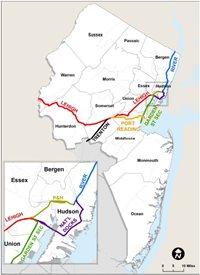 Rowinski said a lot has changed since the initial study was completed, including increases in rail traffic volume that are expected to continue in the future. Train frequency is similar but with longer trains, motor vehicle volume has increased or shifted, there’s been population growth, and an increased emphasis on equity in transportation planning.
Rowinski said a lot has changed since the initial study was completed, including increases in rail traffic volume that are expected to continue in the future. Train frequency is similar but with longer trains, motor vehicle volume has increased or shifted, there’s been population growth, and an increased emphasis on equity in transportation planning.
Today, there’s also access to more data and new data collection methods. For the 2008 study, consultants spent time at locations observing activity around grade crossings and gates. This time, camera equipment was used to gather data at some locations.
The 2008 study, conducted in two phases, looked at a combined 74 crossings. Since that time, several crossings underwent improvements, which affected their ranking in the updated assessment. For instance, Cedar Avenue in Middlesex County ranked second in 2008, but twelfth in the most recent study.
Top 10 grade crossings
- Columbia Avenue, CSX River Line, Dumont, Bergen County
- West Madison Avenue, CSX River Line, Dumont, Bergen County
- Old Hook Road, CSX River Line, Closter, Bergen County
- Inman Avenue, Conrail Lehigh Line, Edison, Middlesex County
- Bergen Turnpike, CSX River Line, Ridgefield Park, Bergen County
- West Clinton Avenue, CSX River Line, Bergenfield, Bergen County
- New Market Road, Conrail Lehigh Line, Piscataway, Middlesex County
- Rahway Avenue, Conrail Lehigh Line, Westfield, Union County
- Stelton Road, Conrail Port Reading Sec, Piscataway, Middlesex County
- South Main Street, Conrail Port Reading Sec, Bound Brook, Somerset County
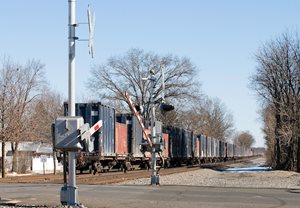
 Each crossing includes a profile summarizing existing conditions and statistics, key issues, and potential strategies, along with images and an aerial map for context. Evaluation scorecards of each crossing included a raw score that was weighted to calculate a total score, by which each crossing was ranked.
Each crossing includes a profile summarizing existing conditions and statistics, key issues, and potential strategies, along with images and an aerial map for context. Evaluation scorecards of each crossing included a raw score that was weighted to calculate a total score, by which each crossing was ranked.
Half of the top 10 crossings were along the CSX River Line in Bergen County, due in part to its high volume of freight rail traffic and population density, according to Chris Lamm, principal consultant with Cambridge Systematics. There’s also a lot of residential land use surrounding those crossings, with proximity to schools and a lot of pedestrian activity.
Nine key issues that came up repeatedly in the data analysis:
- Safety
- Trespassing
- Infrastructure
- Congestion
- Environment
- Community/equity
- Roadway issues
- Active transportation
- Rail operations
This study also details 17 strategies that can be used to address various freight rail issues. Two-page summaries for each strategy were developed and will be incorporated into a rail component of the NJTPA’s Goods Movement Strategies for Communities tool.
The Freight Rail Grade Crossing Assessment Update Final Report is available here. A recording of the Freight Initiatives Committee meeting, including the study presentation, is available here.
Posted: 6/26/2023 4:40:51 PM
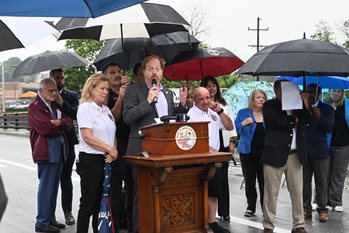 Officials from Bergen and Passaic County joined local, state, and federal representatives to cut the ribbon on the new Fair Lawn Avenue Bridge Monday.
Officials from Bergen and Passaic County joined local, state, and federal representatives to cut the ribbon on the new Fair Lawn Avenue Bridge Monday.
The project, which connects Fair Lawn in Bergen County to Paterson in Passaic County, was completed with federal funding from the NJTPA.
“This project would not have been possible without the support of the NJTPA’s Local Capital Project Delivery Program, which has provided federal funding for every phase of work, from initial planning through construction, making this project virtually 100 percent federally funded,” said Passaic County Commissioner John Bartlett, Chair of the NJTPA Board of Trustees.
He said the new bridge would improve safety and make travel more efficient for residents of Passaic and Bergen counties and the larger region.
“This bridge is just one example of how Passaic County works with the NJTPA and our local elected officials to put federal dollars to work planning and delivering infrastructure improvements,” he said.
Chairman Bartlett noted that Passaic County has two other projects going through the program, the Sixth Avenue Bridge in Paterson, Prospect Park and Hawthorne, and the Main Avenue Corridor in the City of Passaic. In addition, the NJTPA has allocated more than $40 million for safety improvements throughout the county.
Bergen County Executive James Tedesco, who also serves on the NJTPA Board, thanked Passaic County for taking the lead on the project. The counties share ownership and maintenance of the bridge.
“We appreciate the work that was done by all of the folks involved in making this bridge come to fruition, whether it was the funding, whether it was the advocating on behalf of the funds, or whether it was the engineering and the construction putting this together, I say thank you so much,” Mr. Tedesco said.
He also recognized the economic impact the new bridge will have on the region, making it easier for residents to access businesses on both sides of the river.
“That’s why we’re here today, to make sure business survives and thrives, and people’s quality of life is as best as they can get it here in Bergen and Passaic counties, and that we’re committed to making sure the safety of the people that move through the two counties is paramount,” he said.
Congressman Bill Pascrell noted that the original bridge was built in 1905 and was in dire need of replacement. He said it’s one of hundreds of bridges across the state that will benefit from increased federal infrastructure funding.
“By fixing our bridges, we’re enhancing our competitiveness, creating jobs and making America more sustainable, more resilient, fairer,” he said. “We know there are more bridges that need fixing, but today is an example of how the government can get things done when all levels are working and pushing in the same direction,” he said.
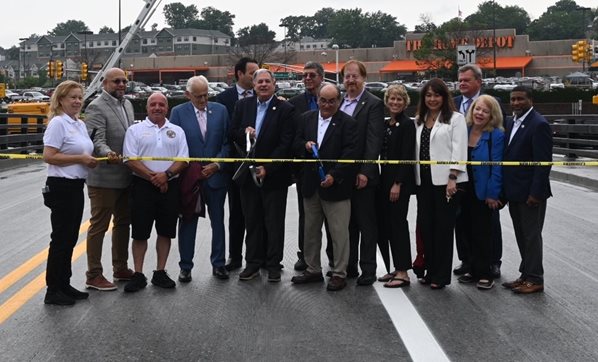
Posted: 6/26/2023 12:12:43 PM
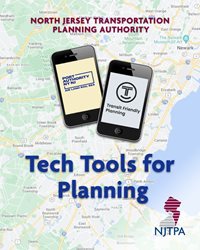 The NJTPA’s 9th annual Tech Tools for Planning Expo on June 13 showcased the suite of dashboards used by the Port Authority of New York and New Jersey to manage and predict real-time traffic needs at its airports, and NJ TRANSIT’s NJ Land Use + Transit Friendly Data Application.
The NJTPA’s 9th annual Tech Tools for Planning Expo on June 13 showcased the suite of dashboards used by the Port Authority of New York and New Jersey to manage and predict real-time traffic needs at its airports, and NJ TRANSIT’s NJ Land Use + Transit Friendly Data Application.
The tools feature innovative uses of Geographic Information Systems (GIS), data visualizations, and web development that can be used for more efficient planning.
Susan Lai, principal traffic engineer at the Port Authority of New York & New Jersey (PANYNJ), said the online dashboards compile various data about the region’s airports as they undergo major redevelopments.
The Port Authority recently completed a major overhaul at LaGuardia Airport, with new Terminals B and C, and opened a new Terminal A at Newark Airport this year. Construction got under way earlier this year on major terminals and roads at JFK Airport. “We’re trying to rebuild these airports at the same time that we’re operating,” Lai said.
The Airport Operations Center (AOC) can help to make decisions before congestion happens, Lai said, using real-time data from traffic cameras, weather monitoring and other sources to pre-emptively place staff and resources where they are needed.
A predictive calendar takes a longer view, taking into account how many seats have been sold in the next two months, culling FlightAware data, and overlay that with construction over the next two months and any other nearby events. “This helps us plan ahead and develop these mitigations for some of these congested days, before they happen,” Lai said.
Another planning dashboard, the Mobility Trend Analysis, shows what passenger volumes are like, whether they’re trending up or down and compares the same months from previous years.
The Transit Friendly Data Application is a free, online tool that allows users to map, report, and download a range of land use, travel, public transit, demographic, and real estate development data. The idea was to create a free online tool that users, no matter their expertise with GIS, can map a range of data that’s related to transit friendly planning, Jon Carnegie, executive director of the Alan M. Voorhees Transportation Center, said.
The second version of the NJ Transit Friendly Data Application includes four new tools: Corridor Planning, Transit-Oriented Development Opportunity, Total Water Levels, and Social Justice.
The Corridor Planning Tool was used in light rail planning along Route 440 on Jersey City’s West side. The tool allows users to run an analysis, which can produce an entire report or just reports for individual stations.
The TOD Opportunity Tool is focused a little more on particular locations and can identify redevelopment and rehabilitation areas.
The Total Water Levels (TWL) Tool helps develop flood exposure analysis using the best available science to create maps that illustrate three flooding types: permanent inundation, high tide flooding, and extreme coastal flooding from storms.
The Equity Analysis Tool is in Beta phase as it makes some “fairly significant changes” this year but is still functioning, Carnegie said. The tool would allow planners to see how different populations could be affected by land use decisions, drawing on demographic data, including race, household income, age and disabilities.
“There will be some evolution of this tool as part of our enhancements and continual improvement plan that we implement with NJ TRANSIT support,” he said.
Posted: 6/22/2023 9:42:59 AM
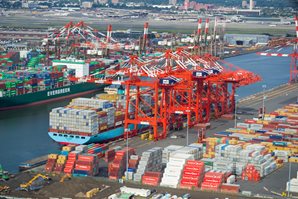 The Port Industry of New York and New Jersey accounted for nearly $15.7 billion in tax revenue, supported over 563,700 jobs, and was responsible for $47.2 billion in personal and $135.3 billion in business income in the region in 2022, according to a new economic impact study released today by Shipping Association of New York and New Jersey.
The Port Industry of New York and New Jersey accounted for nearly $15.7 billion in tax revenue, supported over 563,700 jobs, and was responsible for $47.2 billion in personal and $135.3 billion in business income in the region in 2022, according to a new economic impact study released today by Shipping Association of New York and New Jersey.
The Port has experienced rapid shifts in global supply chains since the 2020 Economic Impact Assessment was undertaken. The Pandemic, combined with additional international trade considerations led to significantly higher volumes of cargo moving through the New York-New Jersey Port. The Port of New York and New Jersey was both the largest operation on the East Coast and for several months, the largest container port in the United States. In addition, more cruise passengers used the Port, and the region’s industrial space continued to increase with millions of square feet added and occupied, according to the study conducted by the North Jersey Transportation Planning Authority (NJTPA). The study looked at the Port’s impact on a 31-county region in New York, New Jersey and Pennsylvania. It also provides data on the economic value generated for the entire states of New York and New Jersey.
“This report highlights something that the NJTPA has long recognized — that the goods movement industry is critical to our region’s economy,” said NJTPA Chair John W. Bartlett, a Passaic County Commissioner. “The industry offers diverse employment opportunities, with direct jobs that include trucking, warehousing, port operations, and banking, and even more indirect jobs, such as construction and equipment sales. We’re proud to play a role in supporting this economic growth by maintaining and improving infrastructure throughout our region, including the roads and rails that keep freight moving.”
According to the study, the Port Industry currently employs 266,200 workers and supports another 297,500 indirect jobs — an increase when compared to the 506,000 jobs supported in 2019. Container volume has also increased by almost 2 million additional containers, since 2019.
“The growth of the New York- New Jersey Port Industry continues to be the fuel that drives the economic engine of the region, generating over 57,000 additional jobs compared to our 2020 report,” said John Nardi, President of Shipping Association of New York and New Jersey.
While the number of cruise vessels declined, the number of passengers increased. This reflected the increased calls of larger cruise vessels with larger passenger accommodations at the Port’s three cruise terminals. At the same time, industrial real estate grew substantially between 2019 and 2022 as companies, responding to heightened demand levels and increased use of ecommerce, sought to keep more inventory on hand. As a result of this growth, the region’s maritime facilities handled:
- Nearly 9.5 million twenty-foot equivalent containers (TEUs)
- Close to 424,000 vehicles
- Nearly 222,000 tons of breakbulk cargo
- 270 larger capacity cruise vessels
“The Port of New York and New Jersey’s ability to absorb the tremendous cargo growth it handled in the past few years has proven to our business partners and port stakeholders that the port’s operations are reliable, efficient and capable of much more to come,” said Bethann Rooney, director of the Port Department at the Port Authority of New York and New Jersey. “In just a decade, the Port has more than doubled the number of direct and indirect jobs in myriad industries that support its operations to nearly 564,000 as a vital part of the regional economic engine. As the region emerges from an unprecedented global pandemic, one thing is for certain: the Port of New York and New Jersey is open, operational, and supporting the nation’s economic recovery through jobs, commerce, billions of tax dollars, and tens of billions of dollars in personal and business activity.”
It is important to note the economic impact assessment of 2022 activities in the New York-New Jersey Port Industry provides a snapshot of the contributions made by the New York/New Jersey Port Industry, as measured in jobs, personal and business income and tax revenues. This economic value is ongoing – the continuing activities of the Port Industry generates and sustains jobs and revenues. As those activities grow and evolve, the economic value generated reflects the new conditions.
Posted: 6/21/2023 9:00:00 AM
Autonomous Vehicles (AV) are being actively tested in select U.S. cities but their widespread use to replace conventional vehicles is a long way off -- perhaps a generation or more. In the meantime, simple things to improve roads for human operators, such as clearer signs and lane markings, will help towns and cities prepare for future AVs.
Those were some of the takeaways from a Symposium on Autonomous Vehicles, hosted by the NJTPA on June 6 in Newark. A video of selected presentations is here.
 AVs were portrayed as a potential means to realize more equitable and sustainable transportation by Jerry He, executive director of the Corporation for Automated Road Transportation Safety (CARTS), a Princeton-based research nonprofit. His organization is providing technical support for Trenton MOVES, the proposed first AV-based urban transit system in the country.
AVs were portrayed as a potential means to realize more equitable and sustainable transportation by Jerry He, executive director of the Corporation for Automated Road Transportation Safety (CARTS), a Princeton-based research nonprofit. His organization is providing technical support for Trenton MOVES, the proposed first AV-based urban transit system in the country.
Trenton MOVES engaged the city’s 90,000 residents over the past two years on designing the proposed system, including the siting of 50 kiosks that will serve as pick-up/drop-off locations for 100 AVs in the city. Companies like Waymo and Cruise have already launched driverless Uber-like services on public roads elsewhere in the country, He said, and other companies are testing and researching their deployment.
Given its population density, He said, North Jersey has a “proof-of-market” opportunity and could lead the nation for equitable deployment of AVs and Autonomous Transit Networks.
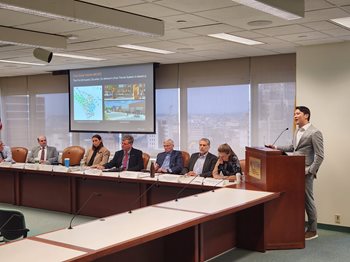 Rather than competing with or replacing transit systems, AVs have the power to improve access to traditional bus and rail transit, according to Meghan Grela, Principal-Autonomous Vehicle Lead at Via, a New York City-based company that runs on-demand microtransit using small vehicles in numerous cities worldwide. AVs she said can serve as an extension of microtransit. “When designed properly, we can make sure AVs are filling gaps in current coverage and not just deploying innovation for innovation’s sake,” she said.
Rather than competing with or replacing transit systems, AVs have the power to improve access to traditional bus and rail transit, according to Meghan Grela, Principal-Autonomous Vehicle Lead at Via, a New York City-based company that runs on-demand microtransit using small vehicles in numerous cities worldwide. AVs she said can serve as an extension of microtransit. “When designed properly, we can make sure AVs are filling gaps in current coverage and not just deploying innovation for innovation’s sake,” she said.
Via operates autonomous microtransit in Grand Rapids, Minn., where it serves senior and disabled populations, and Arlington, Texas, where ridership is comprised mostly of students. Arlington is the first city to rely solely on microtransit, including conventional vans and AVs, for its transit system.
Jack Dean, Program Director, Research & Community Services at NJ Transit, provided insights into the agency’s efforts in testing and evaluating AV shuttles. NJ Transit’s testing location at the former Marlboro Airport in Monmouth County provides a controlled environment for conducting closed-course tests. He said the tests have been promising, with the AVs demonstrating their ability to navigate and respond appropriately in various scenarios such as merging onto main roads, encountering obstacles like garbage cans, and even simulating interactions with pedestrians and animals.
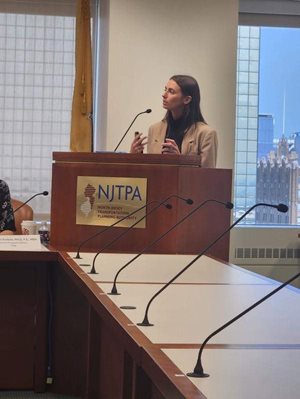 Despite this testing and other efforts around the country, AVs are not on the radar of most municipalities, said Joseph Maraziti, a partner with Maraziti Falcon, LLP in Cedar Knolls and a former chairman of the State Planning Commission. Still, he said towns should prepare for the potential impact of AVs on parking, revenue generation and urban sprawl, while “harnessing the power of public input to create a shared understanding of AV-related changes.”
Despite this testing and other efforts around the country, AVs are not on the radar of most municipalities, said Joseph Maraziti, a partner with Maraziti Falcon, LLP in Cedar Knolls and a former chairman of the State Planning Commission. Still, he said towns should prepare for the potential impact of AVs on parking, revenue generation and urban sprawl, while “harnessing the power of public input to create a shared understanding of AV-related changes.”
Matthew Lawson, principal transportation planner for Mercer County, said he had “high hopes but low expectations” for a future involving AVs, suggesting that their most realistic uses may be moving freight on highways. This, he said, might involve automated platooning of trucks down the New Jersey Turnpike, from the port to the warehouses in Mercer County and surrounding areas.
In the meantime, he said other technologies such as improving the operation and coordination of traffic signals – an effort he is pursuing in Trenton and elsewhere in Mercer County -- could benefit mobility while providing needed infrastructure of future AV operations.
Katherine Kortum, senior program officer at the Transportation Research Board (TRB) added a note of caution about the need for investing to prepare for AVs: “Things that are really going to make our system better, are not shiny, sexy, cool things that tech people in San Francisco like to talk about… They’re things like sidewalks, more funding for transit to have more reliability and frequency.”
She said municipalities should focus on simple things like street signage, road markings and consistent infrastructure that humans can understand and use tomorrow, and that AVs can use “when they get here.” She noted that, with the average car in the U.S. today more than 12 years old, it would take 25 years or more for AVs to take over completely if people started buying them tomorrow – which they can’t.
Connectivity, often overlooked in the AV discussion, has more potential than full automation, according to Kortum. “If vehicles can talk to infrastructure and other vehicles, that would get us a large part of the way toward the goals we have that automation might get us to but much more slowly because automation is much more complicated.”
During the question and answer discussion, speakers agreed that flexible approaches to infrastructure – such as designing parking structures that can be reconfigured, upgrading signal technology and accommodating fiber optic cabling – are important for the uncertain transportation future including wider use of AVs.
Posted: 6/5/2023 10:21:56 AM
The vision of completing the Morris Canal Greenway as a 111-mile continuous pedestrian and bicycle trail connecting six counties is advancing, with work underway on key projects from small and subtle additions, like signs and kiosks to larger projects, like lock restoration and bridges.
The Morris Canal Working Group, coordinated through the NJTPA, met for its semi-annual meeting on May 18. Joe Macasek and Tim Roth of the Canal Society of New Jersey presented updates about various segments of the canal, all in different phases of design, planning, and construction, ranging from interpretative signs and kiosks to more elaborate potential plans like a floating river bridge to connect Waterloo Village with an adjacent inclined plane.
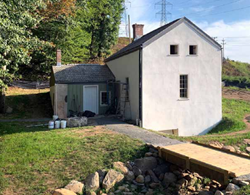 The premier project is the lock and Lock Tenders House in Wharton, which is nearly ready with only a punch list of items to be accomplished, Macasek said. The site has gone through extensive archaeology assessment and construction since it began in 2006. The goal is to have the Lock Tender’s House completed in time for this year’s Canal Day, set for August 19. The lock itself could be finished by the end of the year, he said. A ribbon-cutting ceremony at last year’s Canal Day celebrated major completion of the restoration.
The premier project is the lock and Lock Tenders House in Wharton, which is nearly ready with only a punch list of items to be accomplished, Macasek said. The site has gone through extensive archaeology assessment and construction since it began in 2006. The goal is to have the Lock Tender’s House completed in time for this year’s Canal Day, set for August 19. The lock itself could be finished by the end of the year, he said. A ribbon-cutting ceremony at last year’s Canal Day celebrated major completion of the restoration.
 In Boonton, stabilization of the Arch Bridge is out for bids and could be completed this year, Macasek said. The railroad trestle stabilization as a public walkway is still in the works but has been pushed to 2024. Meanwhile, the state’s Green Acres program will fund acquisition of the railroad turntable. “A lot of this is about connectivity,” he said, and bringing the community together.
In Boonton, stabilization of the Arch Bridge is out for bids and could be completed this year, Macasek said. The railroad trestle stabilization as a public walkway is still in the works but has been pushed to 2024. Meanwhile, the state’s Green Acres program will fund acquisition of the railroad turntable. “A lot of this is about connectivity,” he said, and bringing the community together.
A restoration project for Inclined Plane 4 West, across the river from Waterloo Village, is expected to go under contract this summer. An interpretive canal project this fall will help to define this to visitors, Macasek said, and a floating river bridge is being considered that would connect Waterloo Village with this plane site. “That might be in the offing and that certainly would be a marvelous thing to connect, the visitors at Waterloo to the historic remains of this inclined plane.”
A path along a water-filled section of the canal along Route 202 in Montville will become Dorsey Pond Canal Park later this summer. Macasek described it as “a short but enjoyable stretch of the towpath trail.”
Major projects in Passaic County included the Peckman River Bridge, which is waiting for contracts; the Morris Canal feeder from Wayne to Mountain View, which is in the final design; and, the 4.5-million New York Susquehanna & Western Rail Trail from Pequannock to Mountain View is under construction. Meanwhile, seven different walking trails planned as part of Jersey City’s Greenway Connectivity Plan would all connect with the Morris Canal Greenway.
The greenway is envisioned as a 111-mile trail from the Delaware River in Phillipsburg to the Hudson River in Jersey City, closely aligned with the former canal, which closed a century ago. More information on the canal is available at https://www.morriscanalgreenway.org/